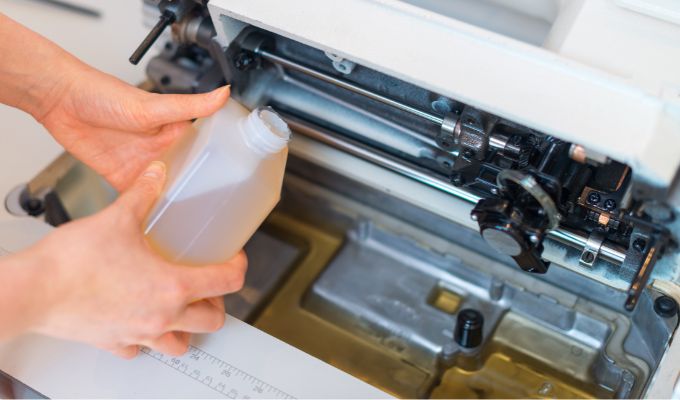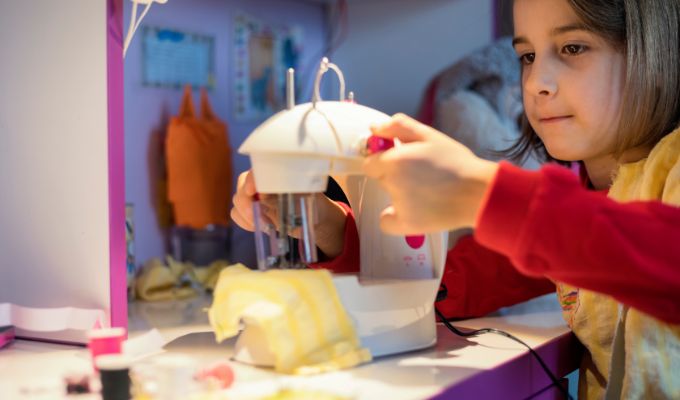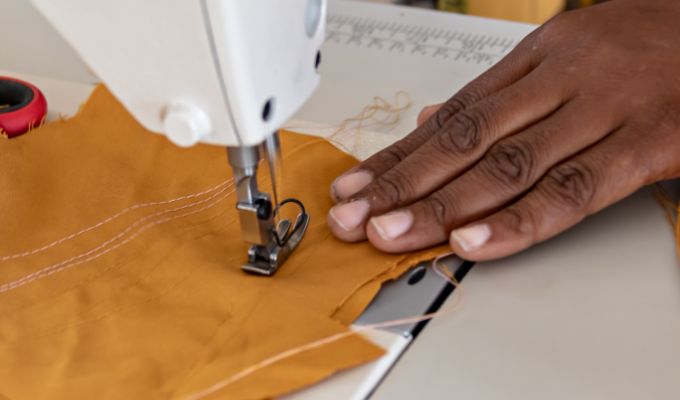No matter how reliable the brand or how impressive the features are, a sewing machine needs routine maintenance, like all machinery. You should frequently oil your sewing as directed by the manufacturer. This will ensure smooth operation and long-lasting reliability of your sewing machine.
How Often Should You Oil a Sewing Machine?
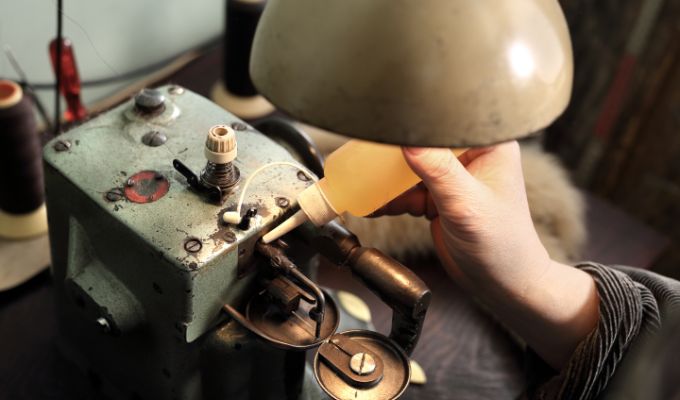
You will find the oiling and lubrication guidelines in your sewing machine user manual. The frequency of oiling will depend on how often you use the machine, and what type of machine you operate. For example, a heavy-duty overlocker has more moving parts and may be used more often than a budget digital sewing machine.
Some industrial sewing machines which have automatic self-lubricating systems do not need intricate component oiling. It is generally advised to lubricate your sewing machine once a year or after 10 hours of operation.
This periodic oiling will help guard your sewing machine against potential breakdowns or malfunctions. The oily coating on moving metal parts will serve as protection, preventing the mechanism from freezing up or wearing down quickly.
Certain sewing machine components will move more easily, with less friction, thanks to the oil, and will make your machine run quieter.
Lubricating With The Correct Oils
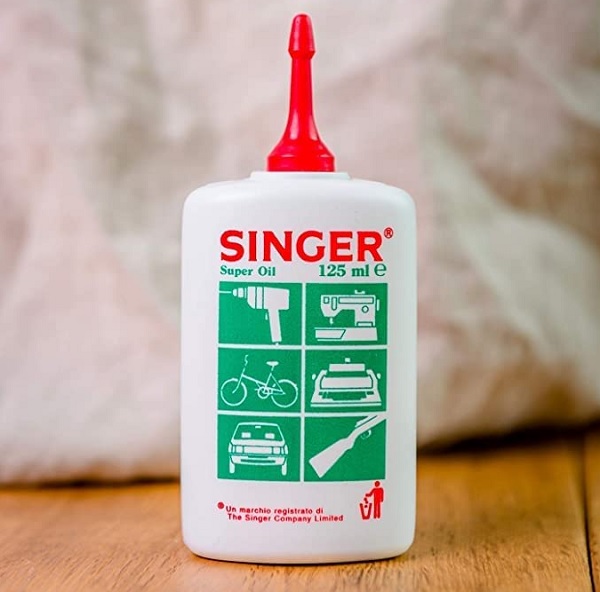
It is crucial to pick a sewing machine oil for device maintenance in order to avoid weakening its system. Avoid using anything else that is greasy or oily.
Sewing machine oil is widely accessible, efficient, and reasonably priced. The necessities for maintaining your sewing machine are available from authorised dealers, supermarkets, haberdasheries, and online businesses.
Sewing machine oil is a liquid, clear fluid that comes in various-sized bottles. Because there won’t be much product applied, the bottle’s capacity will need to be adjusted to the frequency of usage of the sewing machine. The bottles have a specific tip that is long and fine so that you may go along precisely.
Mineral Oil
These mineral oils are derived from petrochemicals, which are themselves derived from petroleum. The most effective mineral oils are odourless, watery white liquids like this one. The majority of lubricants for sewing machines are derived from petroleum. It maintains the metal components of a sewing machine and has anti-rust qualities.
Vaseline oil
Vaseline oil is also a petroleum-based oil – commonly sold as “petroleum” jelly. It is a combination of several oils. This oil has the benefit of having many uses around the house and is appropriate for bike chains, and sewing machine maintenance.
Tri-flow Oil
Tri-flow is a higher-grade mineral oil that is more expensive and has additives to prevent corrosion. If you reside in a region where excessive temperatures or humidity are a concern, it can be a wise choice. Tri-flow oil is considered an industrial-grade mechanical lubricant and is excellent for sewing machines. It comes as a spray-on oil, like WD40, but far better.
Synthetic Oils
A synthetic lubricant, like clock oil, can be used in sewing machines. Along with metal, these oils are suitable to use on painted, rubber, and plastic surfaces. These oils are more expensive and have a somewhat higher viscosity than mineral oil, which reduces their efficiency a little.
Which Sewing Machine Parts to Oil?
It is important to refer to the usage directions if you want to oil your sewing machine without running the risk of breaking it. How to remove the dust cover, oil the moving parts, and clean the bobbin case are all topics that can be covered in the user handbook of your sewing machine. There won’t be a cover to remove for certain components or models, just a few tiny holes for dropping oil into.
You should clean your sewing machine while the protective covers are open before applying the oil. In addition to dust, it frequently contains fabric and thread remnants. Periodic upkeep is a chance to get rid of it. For this use, an accessory such as a brush or brushes can be offered.
Needle Bar
One of the sewing machine’s components that is under the most stress is the needle. It is the most likely to get out of order and distort because of its constant movement and the effects of the speed of the movement applied to it and the thickness of the fabrics to be treated. In order for the needle bar to maintain its mobility, it is crucial to oil it.
Bobbin
Cleaning and oiling are needed for the bobbin case and its internal components. The rotatable hook in the centre and the compartment’s edges will both receive grease application. When wrapping the thread, the lubrication will ensure that these components operate quietly.
Spool
Oil can also be applied on a metal spool pin. It will just cause the yarn to unravel more silently and smoothly.
Use a soft cloth to wipe away any excess oil after you’ve finished oiling your sewing machine.
The sewing machine starts working again right away. It’s crucial to turn your sewing machine back on so that the oil doesn’t dry out and block the mechanism. To get rid of any oily residue and prevent unintended stains on your sewing, it is preferable to work briefly on a scrap of fabric before continuing.
What Oils to Avoid Using
A short list of several oils that you SHOULD NOT use on your sewing machine is provided below:
Vehicle oil
Do not attempt to use motor oil in your sewing machine, as this type of oil is designed to work at high engine temperatures. It’s messy, and smelly, and won’t offer the optimal protection that sewing machine-specific oil can.
WD-40.
For sewing machines, not all lubricants are appropriate. A certain number is unquestionably inappropriate to employ. One of those is WD-40, which can harm a mechanism by reacting with the graphite in mechanical gears. Use spray tr-flow as an alternative.
3-in-1 Oil.
Over time, 3-in-1 oil dries up and leaves behind a gooey residue that clogs moving parts because of its paraffin base. Increased friction brought on by this residue increases the risk of overheating or damage.
Cooking Oil
Even in an emergency, never use any form of cooking oil or fat to lubricate your sewing machine. For sewing machine parts, the viscosity of these oils is too high. In addition, they frequently grip and hang onto lint and dust, which increases friction and eventually jams the internal mechanism.
Every seamstress can easily oil their sewing machine because it is such a simple task, particularly if you follow the manufacturer’s instructions. Whether you sew frequently or perhaps occasionally, it’s crucial to perform this routine act to protect your sewing machine. This simple sewing machine repair only calls for a bottle of appropriate oil.
